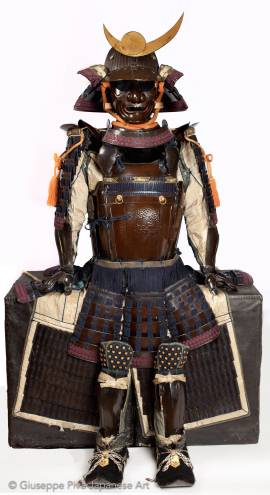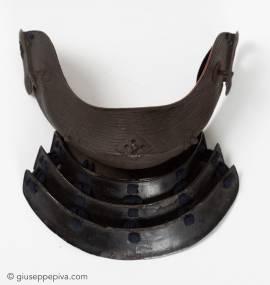Edo period, 18th centuryPair of two-panel folding screens Ink, colors, gofun and gold leaf on paperEach 170 by 165 cm The term karamono is used to define ceramic, carvel lacquerware, furniture, bronzes and other decorative items imported from China. They became highly prized as imported curios, used in Japan as kazari - display items - and even the shōgun would install karamono in his chamber (zashiki) and invite members of the court and clergy to view them. Often karamono have been copied by Japanese craftsmen, so shapes from Chinese bronzes and porcelain have been used in Japan for...
WORKS FOR SALE
Samurai armor in Sendai styleKabuto signed: Myochin Ujiie saku and dated August 1527 PERIODMid Edo period (1615-1868), 18th centurySIGNATUREMyochin Ujiie saku EXHIBITIONS"Samurai - Passato e Presente", Novara 2012LITERATUREG.Piva - S. Verrina, Samurai - Passato e Presente, cat. A3, Novara 2012 The helmet (kabuto) of this authentic samurai armor incorporates on an older bowl (bachi) signed by Myochin Ujiie, an armorer documented in the official Myochin genealogies as second son and pupil of the famous Smith Nobuie. Among the typical...
Early Edo Period (1615-1867)Saika or Haruta School, 17th century A samurai mask of hanbo shape, covering half face and excluding the nose.The surface is finished with parallel lines called yasurime ("file marks”) and all rivets are decorated with applied iron ornaments (kirigane) either in the shape of a chrysanthemum or of lozenges, as typical from the Saika school of armorers. The Saika school was founded in the early 17th century by a group of armor-makers of the Haruta group who moved to Kii province, in the village of Saika.The tare (throat protection) is in...
Copyright © 2016 - giuseppe piva - VAT: 05104180962










